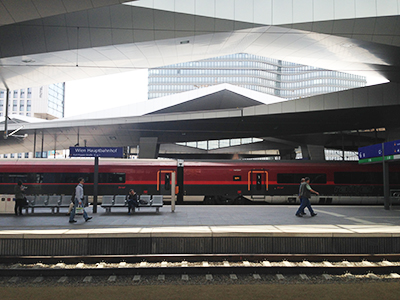
The Orient/east-Mediterranean corridor has a great potential in terms of strengthening sustainable transportation modes: the North and South European ports should be effectively connected through the enhancement of the railway network, thus raising the freight and passenger capacity and reducing travel times and costs. Moreover, such transnational efforts are clearly aimed at territorial cohesion – a key objective of European integration.
In order to better understand the impact of infrastructural improvements on spatial development, we can make the illustration of our planet as our own body: the skeleton is made of roads, railways, air and sea ports; the vascular network consists of gas and oil pipelines and electric grids, while the nervous system is based on internet cables, satellites, data scanners, etc. In sum, infrastructure, being it an instrument of physical connection, energy supply or information share, is an underlying factor generating the connectivity – the key asset class of the 21st century. Thus, the infrastructural upgrading, as it enables all other sectors to function properly, is recognised as one of the 19 UN Sustainable Development Goals.
Europe has a long tradition in understanding the infrastructure, in particular the railway transport infrastructure, as a tool for achieving prosperity and stability – first transnational initiatives date back to the end of the 19th century. Today, the EU TEN-T (Trans-European Transport Network) policy clearly addresses the main objectives of European development – economic, social, and territorial cohesion.
A Backbone for Balanced European Development
However, a macro-region of the Hamburg–Athens corridor is quite a challenging area – it is influenced by various socio-economic models of the past, legal and administrative systems, and planning cultures. In terms of infrastructural bottlenecks, the corridor is faced with even 50% lower performance (taking into account transport modal split for both goods and passengers, as well as rail network density) in comparison to the Rhine–Alpine corridor. Hence, the main starting point addressed by the Hamburg–Athens project is the focus on functional geography, rather on political geography. In other words, national borders and North-South divergences should not impede strengthening the infrastructural network of transnational importance. This approach is underpinned by both global perspective – the corridor overlaps with the most southern branch of the New Silk Road, the railway project funded by the Chinese Investment Bank, as well as with the local factors – post-socialist countries along the corridor still have the bigger share of freight transport by rail than by other transportation means. Hence, the Hamburg–Athens corridor is considered a backbone for balanced European development.
Nevertheless, in order to truly overcome regional disparities, infrastructural development should not stay concerned only with an axial approach. Instead, improving the sub-network at the national and regional scale is a smart way to effectively address major European objectives. Finally, as connectivity provides a quantum leap not only in a mobility of people, goods, resources, but also ideas, it is a key instrument for overcoming administrative, legal and cultural bottlenecks in Europe, thus making a ‘fertile ground’ for territorial cohesion in Europe.
Ana Perić is a postdoc and lecturer at the Chair for Spatial Planning and Development. Her research interests include European dimension of spatial planning, being explored through various transnational projects. Since 2015, she has been engaged as a coordinator of the “Spatial and Transport Development in European Corridors – Example Corridor 22, Hamburg–Athens” project, jointly conducted by ETH and ARL (German Academy for Spatial Planning and Research).